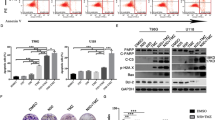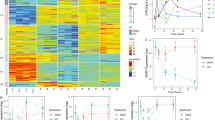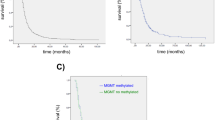Abstract
Drug treatment of malignant gliomas is limited by the intrinsic resistance of glioma stem cells (GSCs) to chemotherapy. GSCs isolated from human glioblastoma multiforme (GBM) expressed metabotropic glutamate receptors (mGlu3 receptors). The DNA-alkylating agent, temozolomide, killed GSCs only if mGlu3 receptors were knocked down or pharmacologically inhibited. In contrast, mGlu3 receptor blockade did not affect the action of paclitaxel, etoposide, cis-platinum, and irinotecan. mGlu3 receptor blockade enabled temozolomide toxicity by inhibiting a phosphatidylinositol-3-kinase/nuclear factor-κB pathway that supports the expression of O6-methylguanine-DNA methyltransferase (MGMT), an enzyme that confers resistance against DNA-alkylating agents. In mice implanted with GSCs into the brain, temozolomide combined with mGlu3 receptor blockade substantially reduced tumor growth. Finally, 87 patients with GBM undergoing surgery followed by adjuvant chemotherapy with temozolomide survived for longer time if tumor cells expressed low levels of mGlu3 receptors. In addition, the methylation state of the MGMT gene promoter in tumor extracts influenced survival only in those patients with low expression of mGlu3 receptors in the tumor. These data encourage the use of mGlu3 receptor antagonists as add-on drugs in the treatment of GBM, and suggest that the transcript of mGlu3 receptors should be measured in tumor specimens for a correct prediction of patients’ survival in response to temozolomide treatment.
Similar content being viewed by others
Log in or create a free account to read this content
Gain free access to this article, as well as selected content from this journal and more on nature.com
or
Abbreviations
- GSC:
-
glioma stem cell
- GBM:
-
glioblastoma multiforme
- MGMT:
-
O6-methylguanine-DNA methyltransferase
- mGlu:
-
metabotropic glutamate
- MAP:
-
mitogen-activated protein
- PtdIns-3-K:
-
phosphatidylinositol-3-kinase
- cAMP:
-
cyclic adenosine monophosphate
- ERK:
-
extracellular signal-regulated kinase
- EGF:
-
epidermal growth factor
- EGFR:
-
epidermal growth factor receptor
- mTOR:
-
mammalian target of rapamycin
- RT-PCR:
-
reverse transcriptase-polymerase chain reaction
- OS:
-
overall survival
- DMEM:
-
Dulbecco’s modified Eagle’s medium
- bFGF:
-
basic fibroblast growth factor
- Sox-2:
-
sex-determining Y-box 2
- DAPI:
-
4,6-diamidino-2-phenylindole
- GSK3:
-
glycogen synthase kinase-3
- SDS-PAGE:
-
sodium dodecyl sulfate-polyacrylamide gel electrophoresis
- MTT:
-
3-(4,5-dimethylthioazol-2-yl)-2,5-diphenyl tetrazolium bromide
- LDH:
-
lactate dehydrogenase
- ChIP:
-
chromatin immunoprecipitation
- GFP:
-
green fluorescent protein
References
Wen PY, Kesari S . Malignant glioma in adults. N Engl J Med 2008; 359: 492–507.
Van Meir EG, Hadjipanayis CG, Norden AD, Shu HK, Wen PY, Olson JJ . Exciting new advances in neuro-oncology. The avenue to a cure for malignant glioma. CA Cancer J Clin 2010; 60: 166–193.
Galli R, Binda E, Orfanelli U, Cipelletti B, Gritti A, De Vitis S et al. Isolation and characterization of tumorigenic, stem-like neural precursors from human glioblastoma. Cancer Res 2004; 64: 7011–7021.
Singh SK, Hawkins C, Clarke ID, Squire JA, Bayani J, Hide T et al. Identification of human brain tumor initiating cells. Nature 2004; 18: 396–401.
Vescovi AL, Galli R, Reynolds BA . Brain tumor stem cells. Nat Rev Cancer 2006; 6: 425–436.
Stiles CD, Rowitch DH . Glioma stem cells: a midterm exam. Neuron 2008; 58: 832–846.
Pallini R, Ricci-Vitiani L, Banna GL, Signore M, Lombardi D, Todaro M et al. Cancer stem cell analysis and clinical outcome in patients with glioblastoma multiforme. Clin Cancer Res 2008; 14: 8205–8212.
Eramo A, Ricci-Vitiani L, Zeuner A, Pallini R, Lotti F, Sette G et al. Chemotherapy resistance of glioblastoma stem cells. Cell Death Differ 2006; 13: 1238–1241.
Hadjipanayis CG, Van Meir EG . Brain cancer propagating cells: biology, genetics and targeted therapies. Trends Mol Med 2009; 15: 519–530.
Cheng CK, Fan QW, Weiss WA . PI3K signaling in glioma-animal models and therapeutic challenges. Brain Pathol 2009; 19: 112–120.
De Witt, Hamer PC . Small molecule kinase inhibitors in glioblastoma: a systematic review of clinical studies. Neuro Oncol 2010; 12: 304–316.
Ciceroni C, Arcella A, Mosillo P, Battaglia G, Mastrantoni E, Oliva MA et al. Type-3 metabotropic glutamate receptors negatively modulate bone morphogenetic protein receptor signaling and support the tumorigenic potential of glioma-initiating cells. Neuropharmacology 2008; 55: 568–576.
Nicoletti F, Bockaert J, Collingridge GL, Conn PJ, Ferraguti F, Schoepp DD et al. Metabotropic glutamate receptors: from the workbench to the bedside. Neuropharmacology 2011; 60: 1017–1041.
Stupp R, Gander M, Leyvraz S, Newlands E . Current and future developments in the use of temozolomide for the treatment of brain tumors. Lancet Oncol 2001; 2: 552–560.
Fiory F, Oriente F, Miele C, Romano C, Trencia A, Alberobello AT et al. Protein kinase C-zeta and protein kinase B regulate distinct steps of insulin endocytosis and intracellular sorting. J Biol Chem 2004; 279: 11137–11145.
Vivanco I, Sawyers CL . The phosphatidylinositol 3-kinase AKT pathway in human cancer. Nat Rev Cancer 2002; 2: 489–501.
Weaver KD, Yeyeodu S, Cusack JC, Baldwin AS, Ewend MG . Potentiation of chemotherapeutic agents following antagonism of nuclear factor kappa B in human gliomas. J Neuro Oncol 2003; 61: 187–196.
Shin HM, Kim MH, Kim BH, Jung SH, Kim YS, Park HJ et al. Inhibitory action of novel aromatic diamine compound on lipopolysaccharide-induced nuclear translocation of NF-kappaB without affecting IkappaB degradation. FEBS Lett 2004; 571: 50–54.
Kopp E, Ghosh S . Inhibition of NF-kappa B by sodium salicylate and aspirin. Science 1994; 265: 956–959.
Inoki K, Li Y, Zhu T, Wu J, Guan KL . TSC2 is phosphorylated and inhibited by Akt and suppresses mTOR signalling. Nat Cell Biol 2002; 4: 648–657.
Argyriou AA, Kalofonos HP . Molecularly targeted therapies for malignant gliomas. Mol Med 2009; 15: 115–122.
Gerson SL . MGMT: its role in cancer aetiology and cancer therapeutics. Nat Rev Cancer 2004; 4: 296–307.
Bobustuc GC, Smith JS, Maddipatla S, Jeudy S, Limaye A, Isley B et al. MGMT inhibition restores ERα functional sensitivity to anti-estrogen therapy. Mol Med 2012; 18: 913–929.
Kaina B, Margison GP, Christmann M . Targeting O6-methylguanine-DNA methyltransferase with specific inhibitors as a strategy in cancer therapy. Cell Mol Life Sci 2010; 67: 3663–3681.
Sontheimer H . Malignant gliomas: perverting glutamate and ion homeostasis for selective advantage. Trends Neurosci 2003; 26: 543–549.
Lyons SA, Chung WJ, Weaver AK, Ogunrinu T, Sontheimer H . Autocrine glutamate signaling promotes glioma cell invasion. Cancer Res 2007; 67: 9463–9471.
Buckingham SC, Campbell SL, Haas BR, Montana V, Robel S, Ogunrinu T et al. Glutamate release by primary brain tumors induces epileptic activity. Nat Med 2011; 17: 1269–1274.
Yoshida Y, Tsuzuki K, Ishiuchi S, Ozawa S . Serum-dependence of AMPA receptor-mediated proliferation in glioma cells. Pathol Int 2006; 56: 262–271.
Ishiuchi S, Yoshida Y, Sugawara K, Aihara M, Ohtani T, Watanabe T et al. Ca2+-permeable AMPA receptors regulate growth of human glioblastoma via Akt activation. J Neurosci 2007; 27: 7987–8001.
de Groot J, Sontheimer H . Glutamate and the biology of gliomas. Glia 2011; 59: 1181–1189.
Schoepp DD, Jane DE, Monn JA . Pharmacological agents acting at subtypes of metabotropic glutamate receptors. Neuropharmacology 1999; 38: 1431–1476.
Prasad G, Sottero T, Yang X, Mueller S, James CD, Weiss WA et al. Inhibition of PI3K/mTOR pathways in glioblastoma and implications for combination therapy with temozolomide. Neuro Oncol 2011; 13: 384–392.
Lavon I, Fuchs D, Zrihan D, Efroni G, Zelikovitch B, Fellig Y et al. Novel mechanism whereby nuclear factor kappaB mediates DNA damage repair through regulation of O(6)-methylguanine-DNA-methyltransferase. Cancer Res 2007; 67: 8952–8959.
Hegi ME, Diserens AC, Gorlia T, Hamou MF, de Tribolet N, Weller M et al. MGMT gene silencing and benefit from temozolomide in glioblastoma. N Engl J Med 2005; 352: 997–1003.
Hegi ME, Liu L, Herman JG, Stupp R, Wick W, Weller M et al. Correlation of O6-methylguanine methyltransferase (MGMT) promoter methylation with clinical outcomes in glioblastoma and clinical strategies to modulate MGMT activity. J Clin Oncol 2008; 26: 4189–4199.
Eoli M, Menghi F, Bruzzone MG, De Simone T, Valletta L, Pollo B et al. Methylation of O6-methylguanine DNA methyltransferase and loss of heterozygosity on 19q and/or 17p are overlapping features of secondary glioblastomas with prolonged survival. Clin Cancer Res 2007; 13: 2606–2613.
Krex D, Klink B, Hartmann C, von Deimling A, Pietsch T, Simon M et al. Long-term survival with glioblastoma multiforme. Brain 2007; 130: 2596–2606.
Martinez R, Schackert G, Yaya-Tur R, Rojas-Marcos I, Herman JG, Esteller M . Frequent hypermethylation of the DNA repair gene MGMT in long-term survivors of glioblastoma multiforme. J Neurooncol 2007; 83: 91–93.
Park CK, Park SH, Lee SH, Kim CY, Kim DW, Paek SH et al. Methylation status of the MGMT gene promoter fails to predict the clinical outcome of glioblastoma patients treated with ACNU plus cisplatin. Neuropathology 2009; 29: 443–449.
Minniti G, Salvati M, Arcella A, Buttarelli F, D'Elia A, Lanzetta G et al. Correlation between O6-methylguanine-DNA methyltransferase and survival in elderly patients with glioblastoma treated with radiotherapy plus concomitant and adjuvant temozolomide. J Neurooncol 2010; 102: 311–316.
Yang Y, Xia F, Hermance N, Mabb A, Simonson S, Morrissey S et al. A cytosolic ATM/NEMO/RIP1 complex recruits TAK1 to mediate the NF-kappaB and p38 mitogen-activated protein kinase (MAPK)/MAPK-activated protein 2 responses to DNA damage. Mol Cell Biol 2011; 31: 2774–2786.
Piret B, Schoonbroodt S, Piette J . The ATM protein is required for sustained activation of NF-kappaB following DNA damage. Oncogene 1999; 18: 2261–2271.
Volcic M, Karl S, Baumann B, Salles D, Daniel P, Fulda S et al. NF-κB regulates DNA double-strand break repair in conjunction with BRCA1-CtIP complexes. Nucleic Acids Res 2012; 40: 181–195.
Miyamoto S . Nuclear initiated NF-κB signaling: NEMO and ATM take center stage. Cell Res 2011; 21: 116–130.
Ricci-Vitiani L, Pedini F, Mollinari C, Condorelli G, Bonci D, Bez A et al. Absence of caspase 8 and high expression of PED protect primitive neural cells from cell death. J Exp Med 2004; 200: 1257–1266.
Martini M, Pallini R, Luongo G, Cenci T, Lucantoni C, Larocca LM . Prognostic relevance of SOCS3 hypermethylation in patients with glioblastoma multiforme. Int J Cancer 2008; 123: 2955–2960.
Acknowledgements
mGlu2/3 receptor ligands were kindly provided by Eli Lilly and Company. The expression plasmid for β-catenin was provided by Dr. RT Moon (University of Washington, School of Medicine, Seattle, WA, USA). The pCDNA3/constitutively active Akt plasmid was kindly provided by Professor P Formisano, University of Naples ‘Federico II’, Italy. The pCDNA3/MGMT plasmid was kindly provided by Professor Alexandre Evrard, School of Pharmacy, Department of Toxicology, University of Montpellier I (Montpellier, France).
Author information
Authors and Affiliations
Corresponding author
Ethics declarations
Competing interests
The authors declare no conflict of interest.
Additional information
Edited by S Kaufmann
Supplementary Information accompanies the paper on Cell Death and Differentiation website
Supplementary information
Rights and permissions
About this article
Cite this article
Ciceroni, C., Bonelli, M., Mastrantoni, E. et al. Type-3 metabotropic glutamate receptors regulate chemoresistance in glioma stem cells, and their levels are inversely related to survival in patients with malignant gliomas. Cell Death Differ 20, 396–407 (2013). https://doi.org/10.1038/cdd.2012.150
Received:
Revised:
Accepted:
Published:
Issue date:
DOI: https://doi.org/10.1038/cdd.2012.150
Keywords
This article is cited by
-
mGlu3 receptor regulates microglial cell reactivity in neonatal rats
Journal of Neuroinflammation (2021)
-
Characterization of primary glioma cell lines derived from the patients according to 2016 CNS tumour WHO classification and comparison with their parental tumours
Journal of Neuro-Oncology (2021)
-
Expression profile analysis of antisense long non-coding RNA identifies WDFY3-AS2 as a prognostic biomarker in diffuse glioma
Cancer Cell International (2018)
-
RETRACTED ARTICLE: Linc00152 promotes malignant progression of glioma stem cells by regulating miR-103a-3p/FEZF1/CDC25A pathway
Molecular Cancer (2017)
-
The anti-vascular endothelial growth factor receptor-1 monoclonal antibody D16F7 inhibits invasiveness of human glioblastoma and glioblastoma stem cells
Journal of Experimental & Clinical Cancer Research (2017)



